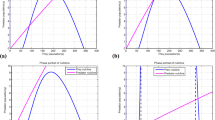Abstract
In this paper, we have proposed a prey–predator model for the study of dynamical behaviors of three species such as toxin-producing Phytoplankton, Zooplankton and Fish in a fishery system. The stability condition, existence condition of equilibrium and bifurcation have also been established. In this paper, Holling type II functional response function has been considered to analysis of the proposed model. All equilibriums of the proposed system are determined, and the behavior of the system is also investigated near the positive equilibrium point. At the end, local stability of the system is analyzed by numerical illustrations.








Similar content being viewed by others
References
Abdllaoui, A.E., Chattopadhyay, J., Arino, O.: Comparisons, by models, of some basic mechanisms acting on the dynamics of the zooplankton toxic phytoplankton systems. Math. Mod. Meth. Appl. S. 12(10), 1421–1451 (2002)
Chattrjee, A., Pal, S., Chattrjee, S.: Bottom up and top down effect on toxin producing phytoplankton and its consequences on the formation of plankton bloom. Appl. Math. Comput. 218, 3387–3398 (2011)
Clark, C.W.: Mathematical Bioeconomics: The Optimal Management of Renewable Resources. Wiley, New York (1990)
Chakraborty, K., Jana, S., Kar, T.K.: Effort dynamics of a delay-induced prey–predator system with reserve. Nonlinear Dyn. 70, 1805–1829 (2012)
Chattopadhayay, J., Sarkar, R.R., Mondal, S.: Toxin producing plankton may act as a biological control for planktonic bloom—field study and mathematical modelling. J. Theor. Biol. 215, 333–344 (2002)
Chakraborty, K., Jana, S., Kar, T.K.: Global dynamics and bifurcation in a stage structured prey-predator fishery model with harvesting. Appl. Math. Comput. 218, 9271–9290 (2012)
Duinker, J., Wefer, G.: Das \(CO_2\) Und Die Rolle Des Ozeans. Naturwissenschahtn 81, 237–242 (1994)
Faria, T., Magalhaes, L.T.: Normal forms for retarded functional differential equations with parameters and Applications to Hopf bifurcations. J. Differ. Equa. 122, 181–200 (1995)
Gakkhar, S., Negi, K.: A mathematical model for viral infection in toxin producing phytoplankton and zooplankton system. Appl. Math. Comput. 179, 301–313 (2006)
Hugo, A., Massawe, E.S., Makinde, O.D.: An eco-epidemiological mathematical model with treatment and disease infection in both prey and predator population. J. Ecol. Nat. Environ. 4(10), 266–279 (2012)
Kar, T.K., Chakraborty, K.: Effort dynamics in a prey–predator model with harvesting. Int. J. Inf. Syst. Sci. 6(3), 318–332 (2010)
Liu, W.M.: Criterion of Hopf bifurcation without using eigenvalues. J. Math. Anal. Appl. 182, 250 (1994)
Ma, Z., Wang, Y., Jiang, G.: Bifurcation analysis of a linear Hamiltonian system with two kinds of impulsive control. Nonlinear Dyn. 70, 2367–2374 (2012)
Makinde, O.D.: Solving ratio-dependent predator–prey system with constant effort harvesting using Adomain decomposition method. Appl. Math. Comput. 187, 17–22 (2007)
Odum, E.P.: Fundamentals of Ecology. Saunders, Philadelphia (1971)
Pradhan, T., Chaudhuri, K.S.: A dynamical reaction model of two species fishery with taxation as a control instrument: a capital theoretic analysis. Ecol. Model. 121, 1–16 (1999)
Pei, Y., Chen, L., Zhang, Q., Li, C.: Extinction and permanence of one-prey multi-predators of Holling type II function response system with impulsive biological control. J. Theor. Biol. 235, 495–503 (2005)
Pei, Y., Zeng, G., Chen, L.: Species extinction and permanence in a prey–predator model with two-type functional responses and impulsive biological control. Nonlinear Dyn. 52, 71–81 (2008)
Panja, P., Mondal, S.K.: A mathematical study on the spread of Cholera. South Asian J. Math. 4(2), 69–84 (2014)
Qu, Y., Wei, J.: Bifurcation analysis in a time-delay model for preypredator growth with stage-structure. Nonlinear Dyn. 49, 285–294 (2007)
Samayda, T.: What is a bloom? A commentary. Limnol Oceonogr. 42, 1132–1136 (1997)
Sarkar, R.R., Chattopadhyay, J.: The role of environmental stochasticity in a toxic phytoplankton-non-toxic phytoplankton zooplankton system. Environmetrics 14, 775–792 (2003)
Saha, T., Bandyopadhyay, M.: Dynamical analysis of toxin producing phytoplankton–zooplankton interactions. Nonlinear Anal. Real World Appl. 10, 314–332 (2009)
Vankatsubramaninan, V., Schattler, H., Zaborszky, J.: Local bifurcation and feasibility regions in differential–algebraic systems. IEEE. Trans. Autom. Control 40(12), 1992–2013 (1995)
Wang, J., Jiang, W.: Bifurcation and chaos of a delayed predator–prey model with dormancy of predators. Nonlinear Dyn. 69, 1541–1558 (2012)
Xiao, D., Li, W., Han, W.: Dynamics in a ratio dependent predator prey model with predator harvesting. J. Math. Anal. Appl. 324(1), 4–29 (2006)
Yunfei, L., Yongzhen, P., Shujing, G., Changguo, L.: Harvesting of a phytoplankton–zooplankton model. Nonlinear Anal. Real World Appl. 11, 3608–3619 (2010)
Author information
Authors and Affiliations
Corresponding author
Rights and permissions
About this article
Cite this article
Panja, P., Mondal, S.K. Stability analysis of coexistence of three species prey–predator model. Nonlinear Dyn 81, 373–382 (2015). https://doi.org/10.1007/s11071-015-1997-1
Received:
Accepted:
Published:
Issue Date:
DOI: https://doi.org/10.1007/s11071-015-1997-1




